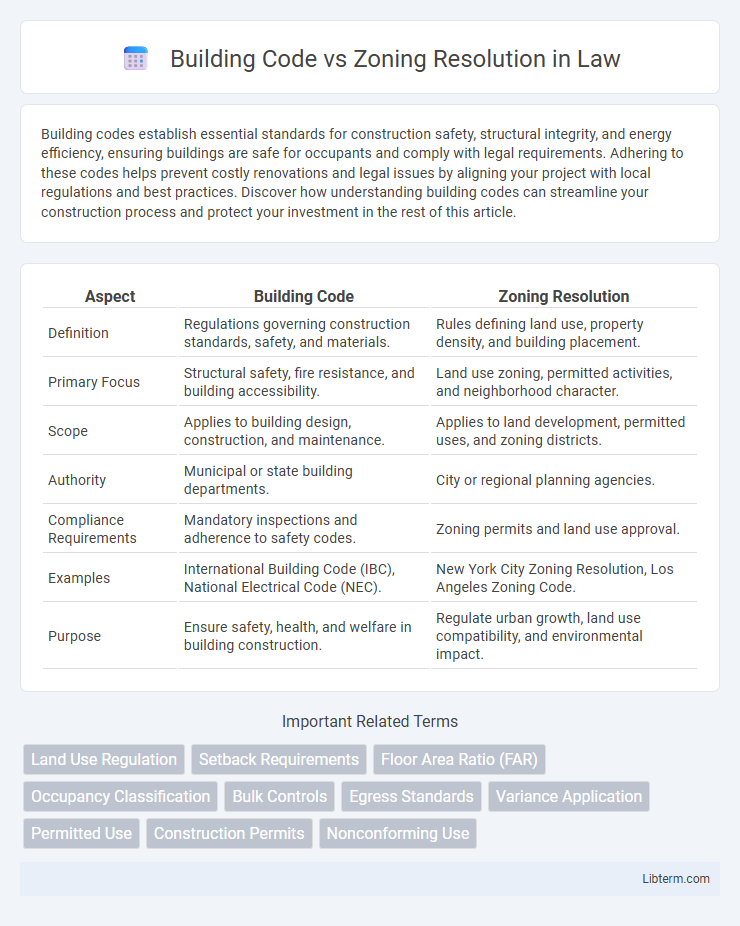Building codes establish essential standards for construction safety, structural integrity, and energy efficiency, ensuring buildings are safe for occupants and comply with legal requirements. Adhering to these codes helps prevent costly renovations and legal issues by aligning your project with local regulations and best practices. Discover how understanding building codes can streamline your construction process and protect your investment in the rest of this article.
Table of Comparison
| Aspect | Building Code | Zoning Resolution |
|---|---|---|
| Definition | Regulations governing construction standards, safety, and materials. | Rules defining land use, property density, and building placement. |
| Primary Focus | Structural safety, fire resistance, and building accessibility. | Land use zoning, permitted activities, and neighborhood character. |
| Scope | Applies to building design, construction, and maintenance. | Applies to land development, permitted uses, and zoning districts. |
| Authority | Municipal or state building departments. | City or regional planning agencies. |
| Compliance Requirements | Mandatory inspections and adherence to safety codes. | Zoning permits and land use approval. |
| Examples | International Building Code (IBC), National Electrical Code (NEC). | New York City Zoning Resolution, Los Angeles Zoning Code. |
| Purpose | Ensure safety, health, and welfare in building construction. | Regulate urban growth, land use compatibility, and environmental impact. |
Understanding Building Codes and Zoning Resolutions
Building codes establish minimum standards for construction, safety, and materials to ensure the structural integrity and habitability of buildings, while zoning resolutions regulate land use, specifying how properties within certain areas can be developed or used. Building codes focus on technical specifications such as fire resistance, electrical systems, and plumbing, designed to protect occupants and property. Zoning resolutions dictate property usage, density, building height, and setbacks to shape urban development and community organization.
Key Differences Between Building Codes and Zoning Resolutions
Building codes set mandatory standards for construction safety, materials, and structural integrity, ensuring buildings are safe and habitable. Zoning resolutions regulate land use, specifying how parcels of land can be used, including restrictions on building types, densities, and purposes within designated zones. The primary difference lies in building codes governing construction quality and safety, while zoning resolutions control land use and urban planning.
Purpose and Scope of Building Codes
Building codes establish minimum standards for construction, ensuring safety, structural integrity, and health regulations in buildings. Their scope covers materials, design, fire protection, electrical systems, and accessibility to protect occupants and property. Unlike zoning resolutions that regulate land use and property development patterns, building codes focus specifically on the technical requirements of construction and building performance.
Role and Function of Zoning Resolutions
Zoning resolutions primarily regulate land use by dividing a municipality into zones that specify permitted building types, uses, density, and setbacks, ensuring orderly urban development and community welfare. They establish legal frameworks that control property development intensity, such as height restrictions and open space requirements, to promote compatible land uses and protect neighborhood character. Unlike building codes, zoning resolutions focus on land use planning and district-level controls rather than construction safety and technical standards.
How Building Codes Affect Property Development
Building codes establish minimum safety, structural, and health standards that directly influence property development by dictating construction methods, materials, and design specifications. Compliance with building codes ensures buildings are safe, energy-efficient, and accessible, which can impact project timelines, costs, and feasibility. Developers must integrate these codes early in the planning process to avoid costly modifications and ensure legal approval for occupancy.
Impact of Zoning Resolutions on Land Use
Zoning Resolutions regulate land use by defining permissible activities and building types within specific districts, directly influencing urban development patterns and property values. These regulations determine the spatial distribution of residential, commercial, and industrial zones, shaping community structure and environmental quality. Compliance with Zoning Resolutions ensures orderly growth, mitigates land use conflicts, and supports sustainable city planning objectives.
Compliance Requirements: Building Codes vs Zoning
Building Codes regulate construction standards including structural integrity, fire safety, and accessibility to ensure buildings are safe and usable, requiring compliance with specific material, design, and workmanship criteria. Zoning Resolutions govern land use, determining permitted uses, density, setbacks, and building height to align developments with community planning goals. Compliance with Building Codes focuses on technical safety and construction methods, while Zoning Resolution compliance ensures conformity to land use policies and spatial planning regulations.
Navigating Permits: Building Code and Zoning Approval
Understanding the distinction between Building Code and Zoning Resolution is crucial when navigating permits, as Building Codes regulate construction standards ensuring safety and structural integrity, while Zoning Resolutions dictate land use, density, and building placement within specific zones. Securing a building permit requires compliance with both sets of regulations, meaning the project must meet Building Code specifications and receive zoning approval based on local ordinances. Early coordination with municipal planning and building departments accelerates the approval process, minimizes costly revisions, and ensures adherence to all permit requirements.
Common Conflicts Between Building Codes and Zoning Resolutions
Building codes establish minimum safety, structural, and accessibility standards for construction, while zoning resolutions regulate land use, density, and building placement within specific areas. Common conflicts arise when building codes require structural modifications that violate zoning setbacks or height restrictions, leading to challenges in compliance. These discrepancies often necessitate variances or special permits to reconcile safety requirements with local land use regulations.
Practical Tips for Managing Building and Zoning Regulations
Navigating Building Code and Zoning Resolution requirements effectively demands a clear understanding of their distinct focuses: Building Codes regulate structural safety and construction standards, while Zoning Resolutions control land use and spatial organization. Practical tips include thoroughly reviewing local municipal codes, consulting with zoning officials before project initiation, and conducting pre-construction site assessments to ensure compliance with both regulations. Utilizing digital tools for code verification and maintaining updated documentation will streamline approval processes and mitigate costly revisions.
Building Code Infographic

 libterm.com
libterm.com